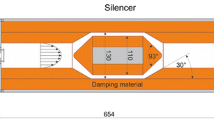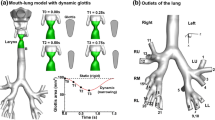Abstract
The detailed analysis of sound generation in human phonation is severely limited as the accessibility to the laryngeal flow region is highly restricted. Consequently, the physical basis of the underlying fluid–structure–acoustic interaction that describes the primary mechanism of sound production is not yet fully understood. Therefore, we propose the implementation of a hybrid acoustic PIV procedure to evaluate aeroacoustic sound generation during voice production within a synthetic larynx model. Focusing on the flow field downstream of synthetic, aerodynamically driven vocal folds, we calculated acoustic source terms based on the velocity fields obtained by time-resolved high-speed PIV applied to the mid-coronal plane. The radiation of these sources into the acoustic far field was numerically simulated and the resulting acoustic pressure was finally compared with experimental microphone measurements. We identified the tonal sound to be generated downstream in a small region close to the vocal folds. The simulation of the sound propagation underestimated the tonal components, whereas the broadband sound was well reproduced. Our results demonstrate the feasibility to locate aeroacoustic sound sources inside a synthetic larynx using a hybrid acoustic PIV approach. Although the technique employs a 2D-limited flow field, it accurately reproduces the basic characteristics of the aeroacoustic field in our larynx model. In future studies, not only the aeroacoustic mechanisms of normal phonation will be assessable, but also the sound generation of voice disorders can be investigated more profoundly.













Similar content being viewed by others
References
Adrian RJ, Westerweel J (2011) Particle image velocimetry. Cambridge University Press, Cambridge
Alipour F, Brücker C, Cook DD, Gömmel A, Kaltenbacher M, Mattheus W, Mongeau L, Nauman E, Schwarze R, Tokuda I, Zörner S (2011) Mathematical models and numerical schemes for the simulation of human phonation. Curr Bioinform 6:323–343
Audier P, Sciamarella D, Artana G (2016) Pre-switching bifurcation of a slender jet. Phys Fluids 28:1–14
Becker S, Kniesburges S, Müller S, Delgado A, Link G, Kaltenbacher M (2009) Flow-structure–acoustic interaction in a human voice model. J Acoust Soc Am 125(3):1351–1361
Bendat JS, Piersol AG (2010) Random data: analysis and measurement procedures, 4th edn. Wiley, Hoboken
Cavalli L, Hirson A (1999) Diplophonia reappraised. J Voice 13:542–556
Chisari N, Artana G, Sciamarella D (2010) Vortex dipolar structures in a rigid model of the larynx at flow onset. Exp Fluids 50(2):397–406
Curle N (1955) The influence of solid bodies upon aerodynamic sound. Proc R Soc Lond 231(1187):505–514
Döllinger M, Berry DA (2006) Computation of the three-dimensional medial surface dynamics of the vocal folds. J Biomech 39(2):369–374
Döllinger M, Kaltenbacher M (2016) Recent advances in understanding the human phonatory process. Acta Acust 102:195–208
Döllinger M, Kobler J, Berry DA, Mehta DD, Luegmair G, Bohr C (2011) Experiments on analysing voice production: Excised (human, animal) and in vivo (animal) approaches. Curr Bioinform 6:286–304
Drechsel JS, Thomson SL (2008) Influence of supraglottal structures on the glottal jet exiting a two-layer synthetic, self-oscillating vocal fold model. J Acoust Soc Am 123(6):4434–4445
Durst F (2007) Fluid mechanics: an introduction to the theory of fluid flows. Springer, Berlin
Durst F, Heim U, Ünsal B, Kullik G (2003) Mass flow rate control system for time-dependent laminar and turbulent flow investigations. Meas Sci Technol 14(7):893–902
Erath B, Plesniak W (2006a) An investigation of bimodal jet tracectory in flow through scaled models of the human vocal tract. Exp Fluids 40:683–696
Erath B, Plesniak W (2006b) The occurrence of the Coanda effect in pulsatile flow through static models of the human vocal folds. J Acoust Soc Am 120:1000–1011
Erath B, Plesniak M (2010a) Viscous flow features in scaled-up physical models of normal and pathological vocal phonation. Int J Heat Fluid Flow 31:468–481
Erath B, Plesniak W (2010b) An investigation of asymmetric flow features in a scaled-up driven model of the human vocal folds. Exp Fluids 49:131–146
Erath B, Zañartu M, Stewart K, Plesniak M, Sommer D, Peterson S (2013) A review of lumped-element models of voiced speech. Speech Commun 55:667–690
Ewert R, Schröder W (2003) Acoustic perturbation equations based on flow decomposition via source filtering. J Comput Phys 188:365–398
Freund J (2001) Noise sources in a low-reynolds-number turbulent jet at mach 0.9. J Fluid Mech 438:277–305
Haigermoser C (2009) Application of an acoustic analogy to piv data from rectangular cavity flow. Exp Fluids 47:145–157
Hamdi M, Havet M, Rouaud O, Tarlet D (2014) Comparison of different tracers for piv measurements in ehd airflow. Exp Fluids 55:1702
Henning A, Kaepernick K, Ehrenfried K, Koop L, Dillmann A (2008) Investigation of aeroacoustic noise generation by simultaneous particle image velocimetry and microphone measurements. Exp Fluids 45:1073–1085
Hirano M (1981) Clinical examination of voice, disorders of human communication, vol 5, 1st edn. Springer, Wien
Hofmans GCJ, Groot G, Ranucci M, Graziani G, Hirschberg A (2003) Unsteady flow through in-vitro models of the glottis. J Acoust Soc Am 113(3):1658–1675
Howe M, McGowan R (2007) Sound generated by aerodynamic sources near a deformable body, with application to voiced speech. J Fluid Mech 592:367–392
Hüppe A, Kaltenbacher M (2015) Investigation of interpolation strategies for hybrid schemes in computational aeroacoustics. In: DEGA (ed) Fortschritte der Akustik—DAGA 2015. DEGA, Nürnberg
Inwald E, Döllinger M, Schuster M, Eysholdt U, Bohr C (2011) Multiparametric analysis of vocal fold vibrations in healthy and disordered voices in high-speed imaging. J Voice 25(5):576–590
Kaltenbacher M, Escobar M, Becker S, Ali I (2010) Numerical simulation of flow-induced noise using LES/SAS and Lighthill’s acoustic analogy. Int J Numer Methods Fluids 63(9):1103–1122
Kniesburges S, Thomson SL, Barney A, Triep M, Sidlof P, Horacek J, Brucker C, Becker S (2011) In vitro experimental investigation of voice production. Curr Bioinform 6:305–322
Kaltenbacher B, Kaltenbacher M, Sim I (2013) A modified and stable version of a perfectly matched layer technique for the 3-d second order wave equation in time domain with an application to aeroacoustics. J Comput Phys 235:407–422
Kniesburges S, Hesselmann C, Becker S, Schlücker E, Döllinger M (2013) Influence of vortical flow structures on the glottal jet location in the supraglottal region. J Voice 27(5):531–544
Kniesburges S, Lodermeyer A, Becker S, Traxdorf M, Döllinger M (2016) The mechanisms of subharmonic tone generation in a synthetic larynx model. J Acoust Soc Am 139(6):3182–3192
Kniesburges S, Birk V, Lodermeyer A, Schützenberger A, Bohr C, Becker S (2017) Effect of the ventricular folds in a synthetic larynx model. J Biomech 55:128–133
Koschatzky V, Moore P, Westerweel J, Scarano F, Boersma BJ (2011) High speed piv applied to aerodynamic noise investigation. Exp Fluids 50:863–876
Krebs F, Silva F, Sciamarella D, Artana G (2012) A three-dimensional study of the glottal jet. Exp Fluids 52(5):1133–1147
Laje R, Gardner T, Mindlin G (2001) Continuous model for vocal fold oscillations to study the effect of feedback. Phys Rev E 64(5):1–7
Lerch R, Sessler G, Wolf D (2009) Technische Akustik. Springer, Berlin
Lighthill M (1952) On sound generated aerodynamically. I. General theory. Proc R Soc Lond Ser A Math Phys Sci 211(1107):564–587
Lodermeyer A, Becker S, Döllinger M, Kniesburges S (2015) Phase-locked flow field analysis in a synthetic human larynx model. Exp Fluids 56(77):1–13
Mittal R, Erath B, Plesniak M (2013) Fluid dynamics of human phonation and speech. Annu Rev Fluid Mech 45:437–467
Neubauer J, Zhang Z, Zhang ZR, Berry D (2007) Coherent structures of the near field flow in a self-oscillating physical model of the vocal folds. J Acoust Soc Am 121(2):1102–1018
Oren L, Koshla S, Gutmark E (2014) Intraglottal geometry and velocity measurements in canine larynges. J Acoust Soc Am 135(1):380–388
Oren L, Khosla S, Gutmark E (2016) Effect of vocal fold asymmetries on glottal flow. Laryngoscope 126:2534–2538
Pickup B, Thomson S (2009) Influence of asymmetric stiffness on the structural and aerodynamic response of synthetic vocal fold models. J Biomech 42:2219–2225
Pierce A (1989) Acoustics: an introduction to its physical principles and applications. Acoustical Society of America, Melville
Raffel M, Willert C, Wereley S, Kompenhans J (2007) Particle image velocimetry—a practical guide, 2nd edn. Springer, Berlin
Scarano F (2013) Tomographic piv: principles and practice. Meas Sci Technol 24:1–29
Scherer R, Witt K, Zhang C, Kucinschi B, Afjeh A (2001) Intraglottal pressure profiles for a symmetric and oblique glottis with a divergence angle of 10 degrees. J Acoust Soc Am 109(4):1616–1630
Sciamarella D, Artana G (2015) Relaxation to one-dimensional postglottal flow in a vocal fold model. Speech Commun 66:176–181
Seo JH, Moon YJ (2007) Aerodynamic noise prediction for long-span bodies. J Sound Vib 306(3):564–579
Sidlof P, Doare O, Cadot O, Chaigne A (2011) Measurement of flow separation in a human vocal folds model. Exp Fluids 51:123–136
Sidlof P, Zörner S, Hüppe A (2015) A hybrid approach to the computational aeroacoustics of human voice production. Biomech Model Mechanobiol 14(3):473–488
Tautz M, Becker S, Besserer K, Hüppe A, Kaltenbacher M (2015) Numerical scheme for acoustic source term calculation in lighthills analogy. In: Acoustics II (IIAV) V (eds) Proceedings of the 22nd international congress on sound and vibration. International Institute of Acoustics and Vibration (IIAV)
Terra W, Sciacchitano A, Scarano F (2017) Aerodynamic drag of a transiting sphere by large-scale tomographic-piv. Exp Fluids 58:1–14
Thomson S, Mongeau L, Frankel F (2003) Physical and numerical flow excited vocal fold model. In: Models and analysis of vocal emissions for biomedical applications: Proceedings of the 3rd international workshop MAVEBA
Titze I (1988) The physics of small-amplitude oscillation of the vocal folds. J Acoust Soc Am 83:1536–1552
Titze I (1994) Principles of voice production. Prentice Hall, Englewood Cliffs
Titze I, Schmidt S, Titze M (1995) Phonation threshold pressure in a physical model of the vocal fold mucosa. J Acoust Soc Am 97(5):3080–3084
Titze I (2000) Principles of voice production, 2nd edn. National Center for Voice and Speech, Denver
Titze I (2006) The myoelastic aerodynamic theory of phonation. National Center for Voice and Speech, Denver
Titze I (2015) Sensitivity of odd-harmonic amplitudes to open quotient and skewing quotient in glottal airflow. J Acoust Soc Am 137:502–204
Triep M, Brücker C, Schröder W (2005) High-speed piv measurements of the flow downstream of a dynamic mechanical model of the human vocal folds. Exp Fluids 39:232–245
Tuerke F, Pastur L, Sciamarella D, Lusseyran F, Artana G (2017) Experimental study of double-cavity flow. Exp Fluids 58:76
Zhang Z (2016) Mechanics of human voice production and control. J Acoust Soc Am 140(4):2614–2635
Zhang C, Zhao W, Frankel F, Mongeau L (2002a) Computational aeroacoustics of phonation, part II: Effects of flow parameters and ventricular folds. J Acoust Soc Am 112(5):2147–2154
Zhang Z, Mongeau L, Frankel S (2002b) Broadband sound generation by confined jets. J Acoust Soc Am 112(2):677–689
Zhang Z, Mongeau L, Frankel SH, Thomson S, Park JB (2004) Sound generation by steady flow through glottis-shaped orifices. J Acoust Soc Am 116(3):1720–1728
Zhao W, Zhang C, Frankel S, Mongeau L (2002) Computational aeroacoustics of phonation, part I: Computational methods and sound generation mechanisms. J Acoust Soc Am 112(5):2134–2146
Zheng X, Mittal R, Bielamowicz S (2011) A computational study of asymmetric glottal jet deflection during phonation. J Acoust Soc Am 129:2133–2143
Zörner S, Sidlof P, Hüppe A, Kaltenbacher M (2016) Flow and acoustic effects in the larynx for varying geometries. Acta Acoust 102:257–267
Acknowledgements
This work was supported by the European Unions Seventh Framework Programme for research, technological development and demonstration under Grant agreement no. 308874. Additionally, the work was supported by the Else Kröner-Fresenius Stiftung under Grant agreement no. 2016 A78. The authors also gratefully acknowledge the funding of the Erlangen Graduate School in Advanced Optical Technologies (SAOT) by the German Research Foundation (DFG) within the framework of the German Excellence Initiative.
Author information
Authors and Affiliations
Corresponding author
Electronic supplementary material
Below is the link to the electronic supplementary material.
Rights and permissions
About this article
Cite this article
Lodermeyer, A., Tautz, M., Becker, S. et al. Aeroacoustic analysis of the human phonation process based on a hybrid acoustic PIV approach. Exp Fluids 59, 13 (2018). https://doi.org/10.1007/s00348-017-2469-9
Received:
Revised:
Accepted:
Published:
DOI: https://doi.org/10.1007/s00348-017-2469-9




